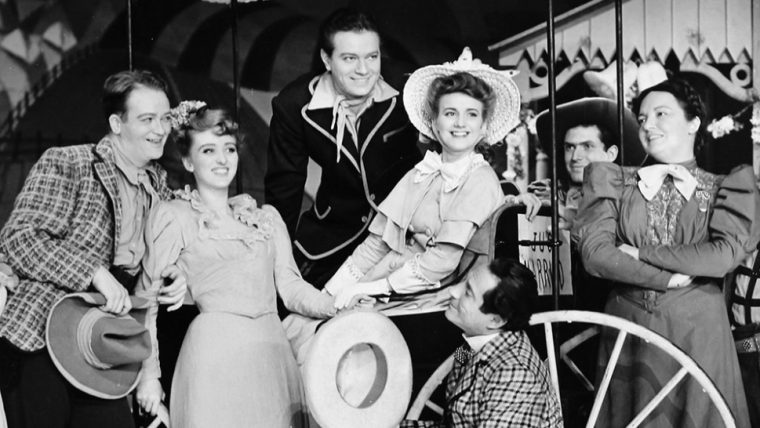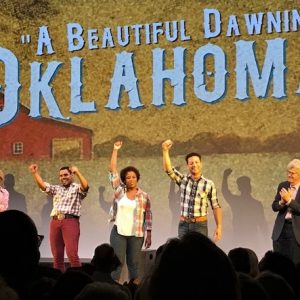
Rodgers & Hammerstein’s first collaboration is more than 75 years old—and it’s having a startling rebirth.
A country-style production on Broadway just won a Tony as the best musical revival of 2019. A production by the Oregon Shakespeare company cast Curly and Laurey, the central couple, as women in a same-sex relationship.
Not only that; another recent production presented a black cast. Actually, the Oklahoma Territory had many such black settlements. The dream of freedom and the availability of land converged in the establishment of all-black communities in Oklahoma towards the end of the 19th century, and a newspaper argued that setting aside one state exclusively for Negroes might be a good idea. The Langston City Herald wrote, “Here the Negro can rest from mob law, here he can be secure from every ill of the southern policies.”
These approaches give new life to a show that enthralled the public in 1943 with its depiction of farmers and cowboys expanding the United States, as newspapers advertised that one could find a home in Oklahoma for the cost of “a Winchester, a frying pan and fifteen dollars.” The settlers optimism, innovation and simple decency inspired a nation during World War II, which was a struggle to preserve those basic American values.
.
This background is illustrated in the production called A Beautiful Dawning: Oklahoma! at 75. It was a one-night benefit concert at the Bucks County Playhouse as part the annual Oscar Hammerstein Festival. Hammerstein owned a farm in Bucks County and wrote Oklahoma!’s libretto and lyrics there.
The production contained documentary narrative, with interesting historical projections and film clips. But, more than that, it was an entertaining two hours of music and humor. The cast was headed by TV and Broadway star Justin Guarini, who is a board member of Bucks County Playhouse. Musical director was Andy Einhorn and staging was by Parker Esse. The script and narration were by Ted Chapin, executive director of the Rodgers and Hammerstein Organization, based on a presentation he made last year at New York’s 92d Street Y.
Richard Rodgers and Oscar Hammerstein teamed up for the first time to create Oklahoma! The idea came from Theresa Helburn of the Theatre Guild. Her group had produced Rodgers & Hart’s first show in 1925, so she reached out to them. Rodgers liked the project but Hart was in the late stages of alcoholism and unfit for any creative work. So Rodgers teamed with his old friend Hammerstein.
They decided to create a musical like no other before, where music, drama and dance would intimately mesh. This was innovative. Let’s remember, Rodgers was a man who put ballet into his On Your Toes and a hustler kept by a wealthy older woman in Pal Joey. Meanwhile, Hammerstein had written about interracial sex and bigotry in his Show Boat.
For the opening scene they decided to skip the conventional chorus line and the expected up-tempo number. Instead, the stage showed only a woman churning butter. Then a man’s off-stage voice is heard singing, “There’s a bright golden haze on the meadow. The corn is as high as a elephant’s eye…Oh, what a beautiful mornin’.”
Rodgers said, “We were, in fact, warning the audience, ‘Watch out! This is a different kind of musical.’”
Hammerstein originally wrote “The corn is as high as a cow-pony’s eye” until he looked out over the corn growing on his farm and realized that wasn’t a tall-enough image. The rest of the score included such enduring melodies as “The Surrey With the Fringe on Top, “People Will Say We’re in Love ” and the catchy title song. The show melded a simple, homespun story to romantic ballads like “Out of My Dreams” and the rippling triplets of “Many a New Day” and the comedy of “I Cain’t Say No” and “Everything’s Up to Date in Kansas City.”
Oklahoma! was a huge cultural landmark. You might say it was similar to today’s Hamilton, except that the general public knew Oklahoma!’s music better. My elementary school friends knew the words to all of the songs. And three of Oklahoma!’s tunes were in the Top Ten of “Your Hit Parade” for most of the year.
The show ushered in a new era for musical theater. This production reprised most of the songs and uncovered material dropped from the show during its pre-Broadway tryout, like “Boys and Girls Like You and Me,” which I first heard sung by Margaret Whiting at a cabaret celebrating Richard Rodgers’ centennial in 2002. An especially funny moment was Guarini as “Ado Andy” singing about his character’s same-sex romantic life, “I’m just a guy who cain’t say no.”
The essence of Oklahoma!’s story is summed up near the end, when Aunt Eller tells Laurey, “You gotta be hearty. You got to be. You cain’t deserve the sweet and tender things in life less’n you’re tough.”
That’s what helped make the show relevant in 1943 and what keeps it going strong today.
